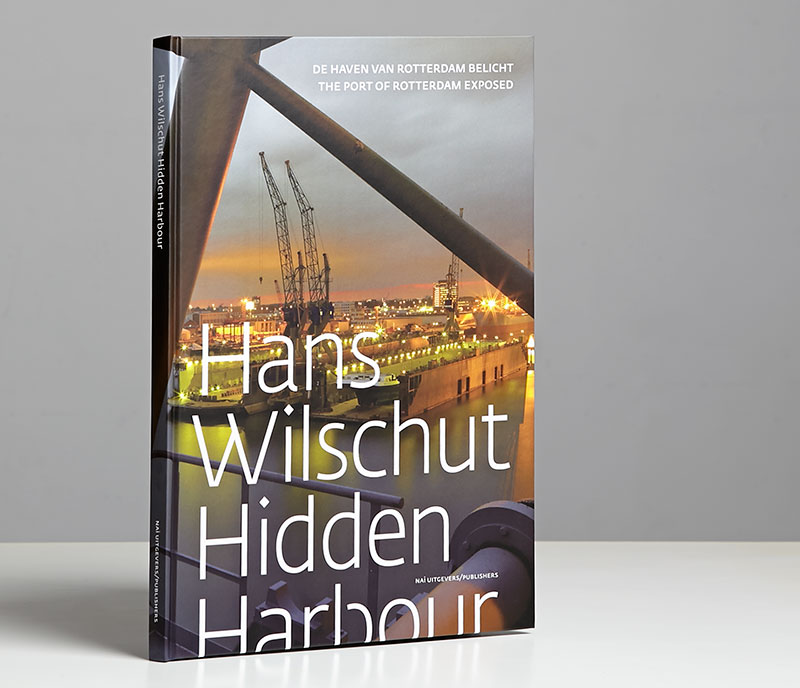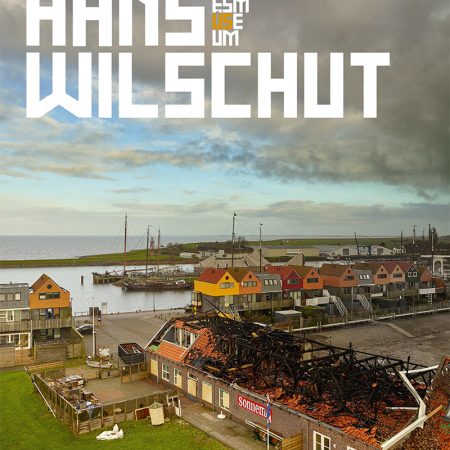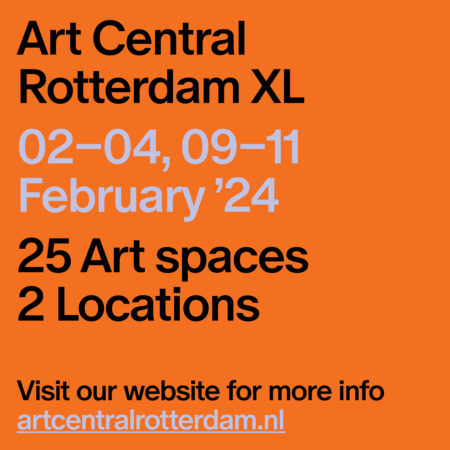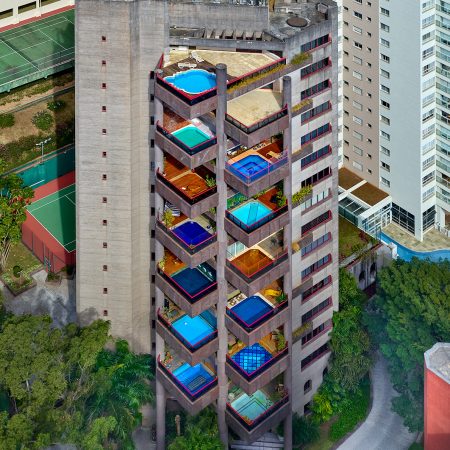Harbour Secrets

by Piet de Jonge
I am standing high above the water on the narrow footbridge of a crane. The blue railing could obviously use a coat of paint. There’s a bit of rubbish on the bridge but I am looking straight ahead, to the other side of the water. Night has just fallen and the lights in the harbour have come on. Bright work lights accentuate a red ship that is surrounded by a couple of large yellow cranes. The blue light coming from the business across from me is reflected in the Maas. To the right of it, two lights cast long green lines on the calm water. From the platform, I can see the harbour of Rotterdam in harsh, brightly coloured lights. The horizon shines, proof that work is still going on there. Here on this footbridge, in the dark and some 40 m up in the air, I feel the magic of this place.
The harbour of Rotterdam is an intangible entity, difficult to describe or portray. The tremendous extent of the area could perhaps be indicated with an aerial photograph or on a map, but then all of the particulars would be lost. Detailed shots of ships, containers, machines or cranes are the other extreme, but they cannot capture what it’s all about, either. Portraits of harbour workers or directors or members of the board might make great pictures, but when it comes to capturing the essence of the harbour? No.
At the beginning of 2009, the Port of Rotterdam Authority asked Hans Wilschut to make a series of photographs about the Rotterdam harbour for their offices on Wilhelminakade. The commission gave the artist complete freedom to do as he pleased, with the understanding that this would build upon his previous work. For some ten years or more now, Wilschut has been fascinated by urban landscapes. In the photographs he takes of major cities, architecture would appear to be the central theme, yet the actual subject of his work is mankind, mankind as the maker of our own environment. Wilschut shows the results of human activity. Sometimes this produces unpleasant images, such as the ruins of an apartment building that collapsed as a consequence of the contractor’s fiddling with permits. But his often large-scale photographs primarily portray the massiveness and impersonality of the environments in which millions of people live.
In order to clearly demonstrate the expanse of such urban areas, he chooses high vantage points, usually the roofs of tall buildings. Using a technical camera, he captures the last glow of the setting sun mixed with the artificial light coming from areas inhabited by people. It is unimpor-tant to him whether a city is in Asia, Africa or America. His photographs show that people live in a different world nowadays than they formerly did. By photographing different places around the globe, he shows that cities are beginning to look more and more alike a veritable global community. Wilschut considers it his task to record whatever he encounters that fascinates him at a certain moment. He exerts an influence on reality by his choice of vantage point and time of taking the photograph, and by the use of modern equipment and computer techniques. These elements also enable him to give his work an extra intensity. For Wilschut, the Port Authority’s commission was in line with this way of seeing the world; he approached the project by asking himself: What is the secret of the harbour?
I am again standing on a crane, this one dating from the 1960s. Ahead of me, I see a colossal blue engine hall. Beneath me, I see the roofs of a number of industrial buildings. One of them is rather overly green, the only roof that is covered with moss. The sun has gone down, its last light reflecting against the clouds, which in turn give the water a purplish red glow. The puddles on the ground betray the fact that it has rained hard recently. As a result, the air is so clear that I can even see the cables of the broadcasting mast straight ahead. The light enchants me. You could even call the view fairylike if it weren’t for those enormous storage tanks and the petrol chemical complex that are such a harsh reality in the background. Below me to the right, steam billows up in a white cloud.
Wilschut drove with his camper from Rotterdam to the Maasvlakte. He followed the harbour along the river and kept being blocked by fences that surround business premises. He soon realized that these places inaccessible to the public offered the most challenge and decided that this was what he wanted to photograph, especially because here he could find the high vantage points needed to convey the vastness of the area“ not tall apartment buildings this time, but chiefly large cranes and high smokestacks. Wilschut gradually developed the idea that these places that are off limit to ordinary people were in fact the real essence of the harbour. With the Port Authority’s commission in his pocket, he approached a number of companies to ask whether he could take photographs for a sketch proposal from the top of a crane or a high platform.
After looking at the test shots, he realized that he was doing what he finds most interesting: taking surveys of areas he doesn’t fully understand.
Before me lies a vast terrain with containers. Moored at the wharf are a few ships still piled high with those giant metal boxes. On the wharf stands a regiment of hoists that have brought earlier loads on land. The terrain has a grid work of rails over which the containers can be moved by means of huge electromagnets. Because of the crisis, the terrain is fuller now than ever. Whereas before this, ships had to wait to be unloaded, now cargos must wait for ships to take them away. The high streetlights bathe the terrain in a golden light, intensifying the colour of the blue paint on the metal loading platforms and containers. The French call this time of the day l’heure bleue, the blue hour: the moment that dusk arrives, when daylight slowly fades away but it is not yet really dark.
With the photos that he had now taken, Wilschut had an easier time of convincing other companies to give up their initial resistance to letting a photographer take pictures on their premises. Yet it often cost him two or three months to receive permission, and especially to convince security guards of the necessity of letting him take photographs at precisely the place and time he desired. Over the period of a year, Wilschut succeeded in penetrating further and further into the harbour’s hidden areas. He developed a special acquaintance with corporations such as emo, the biggest dry bulk terminal in Europe; the shipyard and offshore operations of Keppel Verolme; the Europe Container Terminals; but also Vopak, Aluchemie, and petrochemical industries such as Argos Oil, ExxonMobil and Shell. He discovered the advantages of globalization: a crane that hoists a container onto a ship in China must be the same as a crane in Rotterdam. In order to function as a multinational, standardization is essential.
Between huge mounds of iron ore and coal runs a long straight road with a conveyor belt alongside it, apparently extending to the horizon. The gigantic yellow monster that I am standing on is brightly lit and rides slowly, but with jolting movements, towards the silos at the end of the street. The dimensions are overwhelming, the distances appear endless and the quantities immeasurable. It looks like a scene in a sciencefiction film. The tops of the artificial hills are dark silhouettes against the evening sky. In the distance, you can see the cranes that unload the ships and bring in more commodities. Despite the crisis, the company is having a peak year, because money is now being earned from the storage of cargo in the harbour. I ride further along the road, guided by the lights next to the conveyor belt.
Wilschut gradually got a better idea of the area and a growing understanding of the difficulties of photographing the Rotterdam harbour’s industrial landscape. He drove around in his bus in order to experience locations under different conditions and says that during that period it seemed that he was constantly on the lookout for little balconies. For he had discovered that in addition to the fences that surround the terrains, there are also very many railings and fences at higher levels. They came in very handy for him as a photographer, and ultimately became the visual constant in this project. He used the constructions on platforms and footbridges in the foreground of every photograph as a visual introduction to the terrain lying behind them. In this manner, he tried to capture the industrial panoramas of Europoort, the Botlek and the Maasvlakte. No really high vantage points were to be found in the old Rotterdam harbours, so there he could not get the overview that he needed. It was necessary to be far away from his subject matter because he wanted to portray it as a universal harbour. By avoiding recognizable details such as the Euromast, the Erasmus Bridge and the SS Rotterdam, Wilschut prevented his pictures from becoming topographical anecdotes.
The project that he ultimately made for the Port of Rotterdam Authority consists of 17 photographs that are printed on canvas and framed in boxes lit by led lights. These light boxes are mounted in as many lift waiting areas. They are as large as the end wall (256 x 355 cm) of the space in which the six lift doors are situated. When visitors come out of a lift, they see one of the enormous photographs, in which the railings always form a link between the viewer and the landscape. Wilschut uses pipes and beams with their at times bright colours to lead the viewer across various terrains along the river: a container depot, a conveyor belt for iron ore, or the new air purification system of an aluminium factory.
The streetlight right above me on the fire escape has not yet gone on. I have just seen the sun setting and have also seen the lights on the terrain slowly coming on. The large streetlight I am standing under is mounted on top of the roof, so it will take a few minutes before the sensor turns on its sodium vapour lamp. The thick pipes of the enormous installation are still new and have a silvery glimmer in the bright light. Hanging in the air are dark purple clouds that are more reminiscent of an American Western than a Rotterdam industrial terrain. In the meantime, I am amazed by that little tree standing over there, looking so forlorn among all that metal.
Wilschut took almost all of his photographs right after sunset. He uses this moment, when there is a particular mixture of daylight and artificial light, because colours gain an extraordinary intensity at that time. Clouds lose their mass and become silhouettes, dramatically backlit by the last rays of the sun. By photographing each of the terrains at the same moment of the day, he creates a unity between the various subjects. He is well aware that he makes free use of aesthetics, but he does this in order to show people things they normally would never notice.
A walk through the Port Authority building confirmed this. Employees entering and exiting the lifts were all enthusiastic about the photographs in the building and said that they are proud of “their” harbour. They see familiar places in an unfamiliar way. The railing at the foreground gives you the feeling that you are really standing in the harbour and that you could turn around and look in the other direction. When you see the businesses in the photographs, you know what sounds go with them. These sorts of association come up because Wilschut gives his images such a keen intensity.
Wilschut is looking forward to the last photograph he plans to take for this assignment. He knows exactly what vantage point he needs to conclude his project. The only problem is that it does not yet exist. Although 139 million m3 of sand have been raised in one year’s time, the second Maasvlakte has not yet been completed. A special crane was developed to make a dam wall out of blocks of basalt measuring 2 m3. They come from an old dike that is no longer in use and smell of mussels and seawater. The crane is constructed so that the blocks can be deposited very precisely. Called Blockbuster, it is a brilliant blue and has yellow railings. Wilschut thinks it would be terrific to take a photograph of the newest part of the Netherlands, the newest harbour, from the top of that particular crane, far off shore, and with such a fine yellow railing in the foreground.


